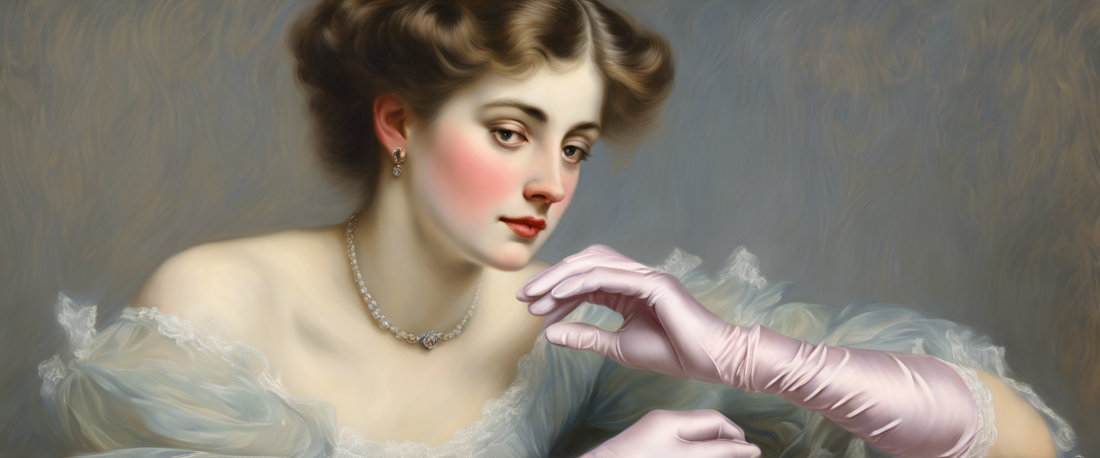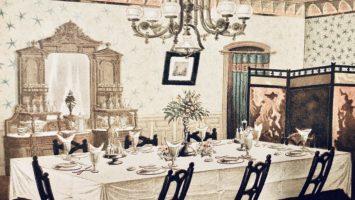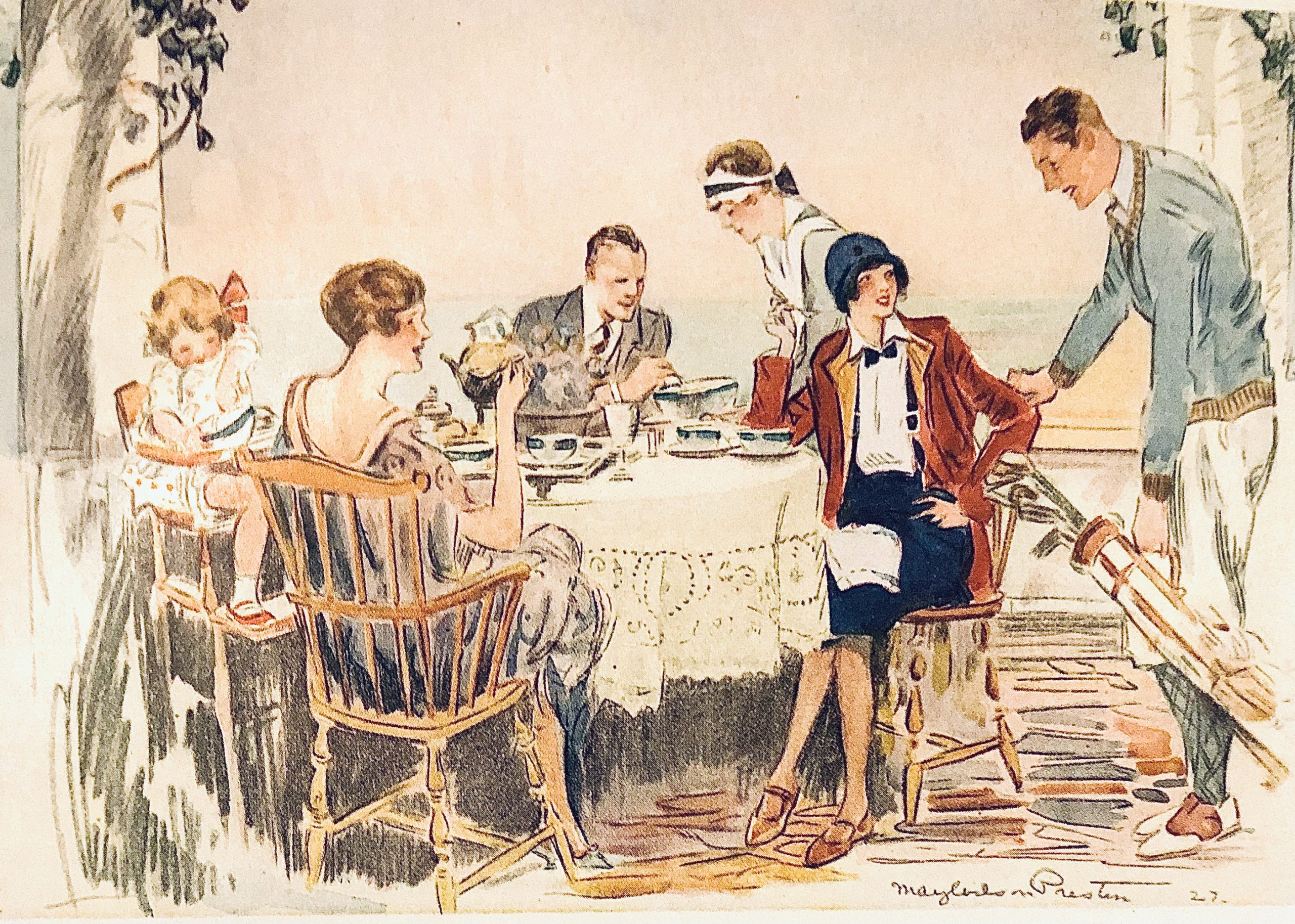Glove etiquette really isn’t all that complicated. In the 19th and early 20th century, one generally wore them when one left the house. They were expected to be clean, well fitted, tight to the hand and matched to ones outfit.
“Worsted or cotton gloves are not permissible anywhere, nor under any circumstances. Ungloved hands are preferable.
Gloves are worn in the street, at an evening party, at the opera or theatre, at receptions, church, when paying a call, driving or riding; but not in the county, nor at a dinner. White is de rigueur for balls; the palest color for evening parties; neutral shades for church.”
Sensible Etiquette of the Best Society by Mrs. H. G. Ward (1878)
Now I want you to notice something about etiquette books. Below are two different books written by different people in 1882. Pay attention to the wording:
“Gloves are worn by gentlemen as well as ladies in the street, at an evening party, at the opera or theatre, at receptions, at church, when paying a call, riding or driving; but not in the country or at dinner. White should be worn at balls; the palest colors at evening parties and neutral shades at church.”
Our Deportment by John H. Young, A.M. (1882)
“Ladies and gentlemen wear gloves on the street, at evening parties, to the opera, or theatre, at receptions, at balls, at church, when making a call, riding or driving; but not at a dinner. White gloves should be worn at balls; delicate tints for evening parties, and any shade at church.”
American Etiquette and Rules of Politeness by Prof Walter R. Houghton & others (1882)
Yes, that’s right. They just copy Mrs. Ward’s advice. And though I do not have evidence of it, I suspect she may have copied someone before that, (it’s the British spelling of theatre that seems suspicious). Now that is partly because these rules were pretty clearly understood by those in the know. The rules regarding gloves also did not change greatly in the four years between each books publication. Really, there were only minute changes in glove etiquette over the entire 19th century.
One important thing to note is that many general etiquette books were copy and pasted from more authoritative guides, with local rules tacked on to make them relevant to the reader. A local publisher might want an etiquette guide and so they would bring in a gun for hire to write one, but society ladies and gentlemen were very unlikely to want or need this job, meaning a person with little experience of the upper classes ended up writing these guides; which led to a lot of plagiarism. Mrs. Ward was published in Philadelphia, while Our Deportment was published in Michigan and Missouri, and American Etiquette was published in Chicago, Illinois. I can’t say what the background of these women were.
Where these guides are helpful is in the local details. In Chicago, no mention is made of the country and apparently anything went color-wise at church. Chicago society didn’t normally have country houses as one might in New York City or Philadelphia, so the writer just eliminated that rule.
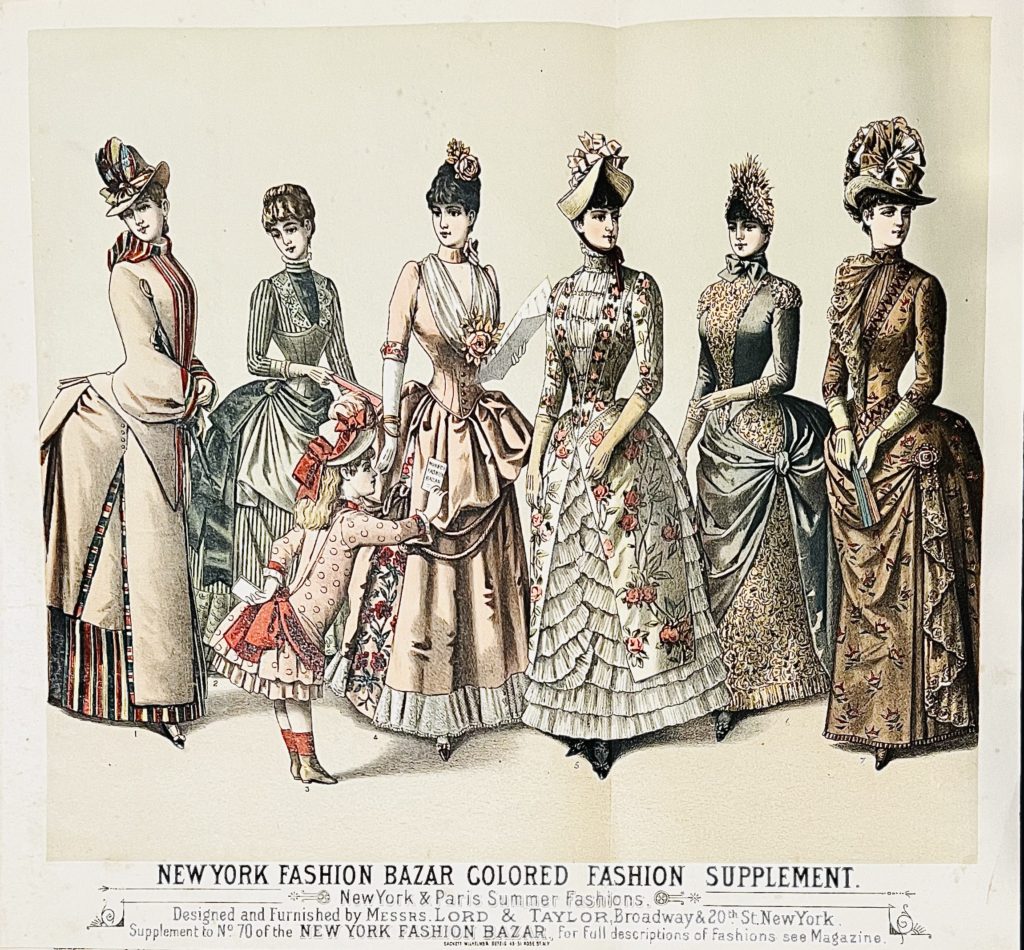
Less organized, but more reliable are guides written by people who actually lived amongst the classes that set the standards. Sadly, these guides tend to be heavy on judging people outside of their own class, and aren’t written in well formatted ways. Case in point:
On Morning dress for the Street:
“Lisle thread gloves in summer and cloth ones in winter will be found more serviceable than kid ones.”
Business woman’s dress:
“…gloves which can be easily removed…”
On Promenade:
“The dress for the promenade should be in perfect harmony with itself. One article should not be new and another shabby. The gloves may not be on one color, the bonnet of another, and the parasol of a third. All the colors worn should at least harmonize if they are not strictly identical.”
Complete Etiquette for Ladies and Gentlemen by Mrs, E.B. Duffey (1911)
There is one interesting change between Mr. Young, writing in the late 19th century and Mrs. Duffey in 1911, cotton gloves became acceptable in the summer. I guess sweaty hands fell out of favor.
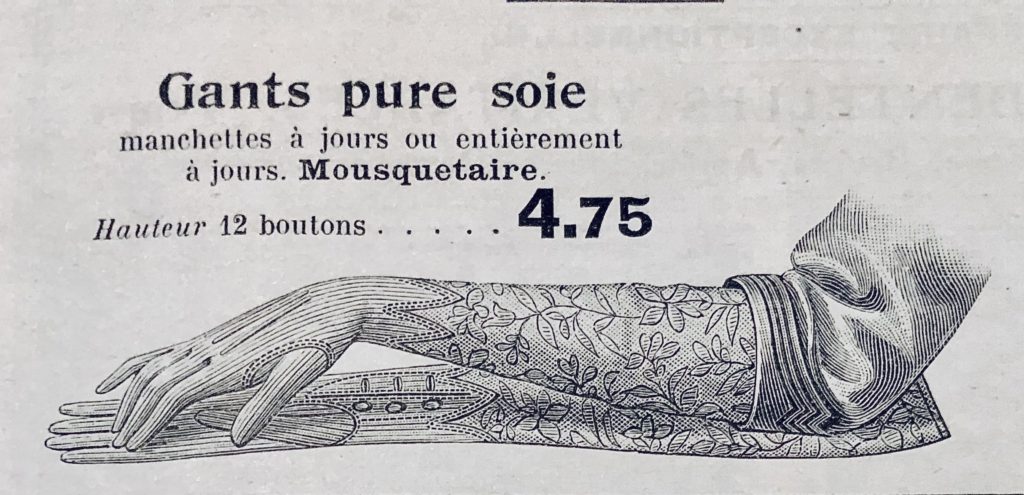
Gloves continued in much the same fashion until the twenties. Though despite the flappers reputation for rule-breaking, generally most people continued to wear gloves in public in much the same manner as they had at the turn of the century. Very slowly the thirties and the forties began to see changes to when are wear gloves would be appropriate. As more women began to work, and as expectations about women’s propriety shifted, gloves slowly became a fashion accessory, not an absolute social requirement.
Through the 50’s and into the 60’s, gloves stopped being required with your daily wardrobe, but they were still ubiquitous. Most women would still have worn gloves at church, formal events and weddings. Upper class women would have worn gloves with most of their outfits, while middle class moms would not have been expected to wear them to pick up the kids or shopping. Depending on how traditional your community might be, gloves would have been used more or less in keeping with how they’d always been worn. Part of the issue here is that you still had an older generation who wore gloves as a matter of course. The example of elders is a tough thing to break. There was also the stigma associated with having hands that looked like they did labor. Tanned or worn hands were seen as marks of lower class status well into the 1970s in many, (though not all) circles. Add to the grand old tradition of American racism, and keeping ones hands white could be seen in some circles as a requirement for social standing, this meant wearing gloves out of doors.
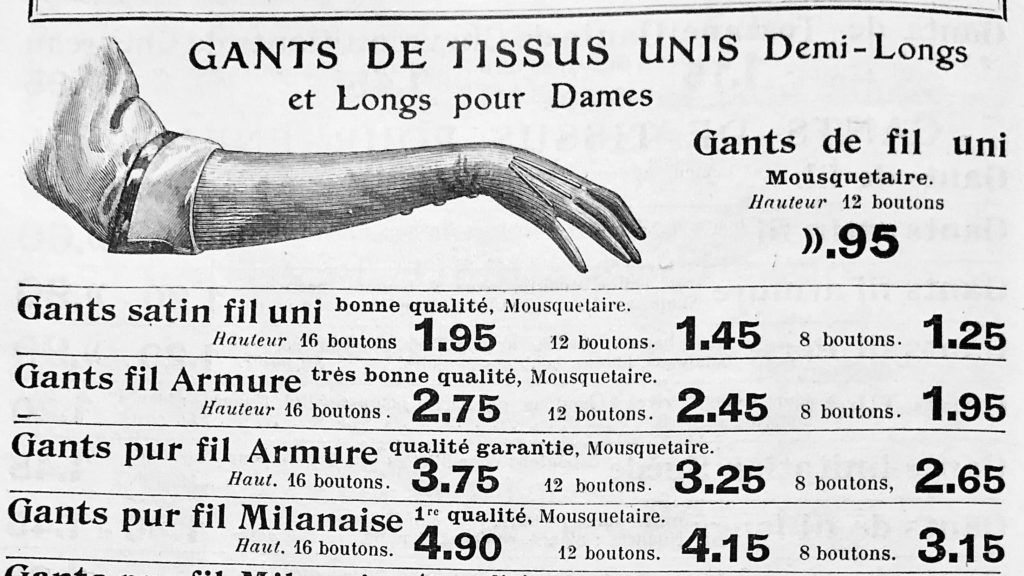
One of the things I find interesting is how many more instructions a guide from the sixties gives a lady on how and when to wear gloves. As I have oft repeated in these posts, etiquette guides told you the things that people were getting wrong or were not expected to know. A victorian lady didn’t need to be told that she should not go out in public with out her gloves, it would have been as expected as wearing her hair up. Everyone knew and followed these rules, so there was no need to put them in a guide. By the sixties, the rules around gloves were loosening, so people needed guidance on how to use them. There was also a good deal of social mobility following the post war years and so there were more young ladies who had the means to aspire to act like a lady, but without anyone in the family familiar with the rules. This is the reason the fifties and sixties see a boom in deportment, “modeling” and debutante instruction.
“Gloves add a brisk, smart flourish to whatever you’re wearing – a suit, an afternoon or evening dress, riding or (even though on one hand only) golf clothes. They have the same kind of immaculate, staccato chic that white spats give a band of Scottish pipers marching down the street. Gloves are stylish only when they are spanking clean, in perfect repair. Wrist=length gloves, plain or with the simplest sticking, are perfect – and you have a fabulous selection of cottons, nylons, knits, wools and leathers to build your glove wardrobe from. Some ceremonious occations__a coming-out party, a ball__may demand long gloves. be sure they fit and remember never to jam the hand part of the glove into a lump on your wrist so you can eat supper. (Take them off.)
At Dances:
“Gloves can be worn while dancing, and as a matter of fact, it’s correct to wear gloves in public for anything except eating or serving refreshments (yes, you can even shake hands with gloves on __individually or en masse, in a reception line).”
At a Restaurant:
“Gloves? Wear them to the table, then take them off as soon as you sit down, lay them on your lap or put them in your bag. Never, never, never wear gloves at a table. That’s a mannerism, not manners.”
While shopping:
“Be as careful with the store’s merchandise as if it all belonged to you__never rummaging through white blouses with smudgy gloves (you take them off)…”
For the Bride:
“And a final thing: your gloves. If you dress has very short sleeves and the effect you wish necessitates long gloves, you’ll have to slit the undersea of your ring finger for the ceremony. Better solution; short gloves, which can be easily pulled off at the altar. You don’t put them back on once you’ve married; just given them to your maid of honor and she’ll carry them out under her bouquet.”
The Seventeen Book of Etiquette and Entertaining by Enid H. Haupf, (1963)
By the eighties, gloves had mostly disappeared. Where and when one might wear gloves becomes more specific and obscure. This doesn’t mean they weren’t worn. I can remember wearing gloves to church as a little child and I was not alone. We also wore a lot of fingerless gloves at one point, but the less said about that, the better.
It is true that what had once been seen as a requirement for any modest lady, was now only required at the most formal of events.
“Gloves, once a necessary accessory for both men and women, are now worn regularly by neither. Only a few occasions remain where women are considered improperly dressed if they are not wearing gloves.
Bridal Parties. Until very recently brides and bridesmaids were not considered properly dressed unless they were wearing gloves. these are no longer required, but, depending on the style of the dresses, many brides still opt to be glove their wedding party. If gloves will complete the outfit, they are worn, If they are not needed to complete the outfit, they are not worn. When a bride wears a long sleeved dress, she often chooses not to wear gloves.
Private Papal Audience. Women are expected to wear gloves to a private papal audience.
Women at Religious services. Gloves never were required in the sense that hats were, but the time was when no well-dressed woman set foot inside a church without wearing gloves. Many women today still choose to wear gloves to religious services.
White House. At Formal White House dinners, women wear long (above the elbow) gloves.”
The New Etiquette by Marjabelle Young Stewart (1987)
Now we live in a time where gloves are almost never worn, even at the White House. There are countries that still wear gloves to fancy events. It’s still expected that you’d wear gloves at a Royal or Papal event. Italians wear gloves far more than Americans. There are still balls in Vienna and Venice where long gloves are de rigueur.
As I’ve said before, you won’t be surprised that I love gloves, even though they make me look like I’m burying a body for Poirot to find.. Hopefully we can bring them back as a fun accessory.
Next time I hope to go a bit further back to the Regency and before when glove etiquette was being codified in print for the masses. Sending you much love, Cheri
